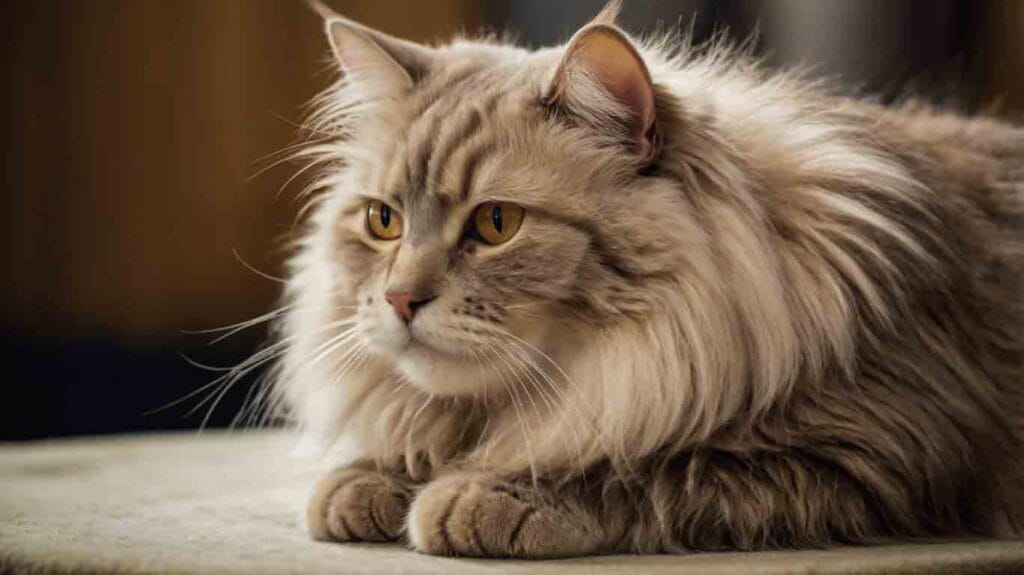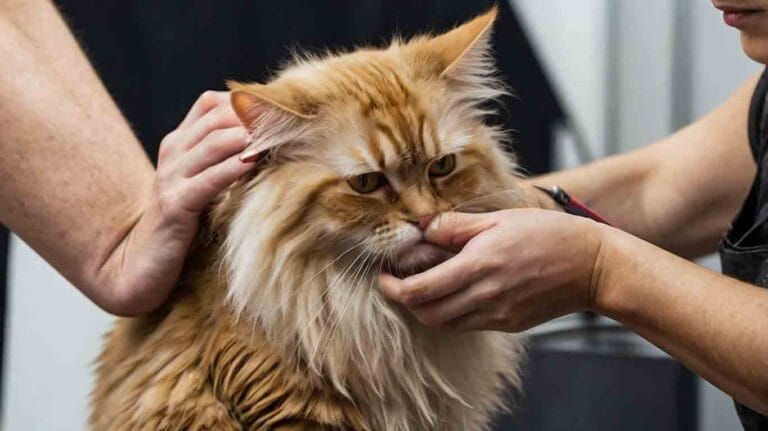Cats overgrooming is first blush may seem like a harmless activity, can nevertheless cause serious medical problems for felines and great emotional duress for the cat’s human.
To better understand this behaviour, the underlying reasons should be understood in order to stop and prevent this.
In this article, we’ll look at why cats overgroom, how to identify the issue and perhaps more importantly, how to stop it. Let’s see how to stop your cat from overgrooming?
Why Cats Overgroom
Psychological Reasons
Most cats are very sensitive creatures and the way they groom themselves is frequently a barometer of their mental well being.
Stress and anxiety and boredom are the two primary reasons a dog overgrooms.
Stress and Anxiety
Unlike humans, cats can get stressed for all sorts of reasons ranging from changes in the household, the arrival of other pets or family members, or even swapping out a few inches of chair or couch.
This stress can cause a cat to develop psychogenic alopecia, which is compulsive grooming to self-soothe.
Grooming releases endorphins, which are a temporary relief for anxiety that leads quickly to a habit.
Boredom and Lack of Stimulation.
It should come as no surprise that indoor cats are susceptible to boredom caused by the absence of brain and body stimulation.
If a cat isn’t getting enough play, exercise, or interactive activities, there’s a good chance that s/he will compensate by overgrooming.
Cats who spend a good amount of time alone without any engaging activities are more often the culprits.
Medical Reasons
Medical problems can also cause overgrooming.
Allergies and infections are where they hit hardest.
Irritation as a result of allergic reactions to food, environment, or substances causes the skin to be excessively groomed.
For instance, if a dog has a flea allergy, it can cause irritation at the base of the tail, and ear mites result in hair loss and scabbing of the neck and ears.
Excessive chewing of the paw pads may be the result of an environmental allergy, which would be to pollen, for example.
Parasites and skin conditions
Overgrooming can also be the result of parasites such as fleas and ear mites, and there can be skin conditions such as ringworm.
These conditions create discomfort, and itching, thus, the cat starts to excessively groom to get rid of the discomforts.
Signs of Overgrooming
We will identify overgrooming in this section. Early intervention is very crucial in recognizing the signs of overgrooming.

Physical Indicators
- Excessive Fur Loss: Often one of the most obvious signs is the cat’s fur is falling out, especially in areas around where you think the cat is grooming too much.
- Skin Sores and Irritation: Skin sores, redness, irritation, abscesses, infections, and outright pain result from overgrooming, which can be torturous for the cat.
Behavioural Changes
- Increased Grooming Frequency: If your cat is grooming much more than usual, he or she could be overgrooming.
- Changes in Appetite or Sleep Patterns: Overgrooming can also cause stress and anxiety, along with changes in appetite or sleep patterns to show something is amiss.
Medical Issues: The Underlying Causes
If overgrooming is not due to a medical condition it is important to discover what medical condition the cat has and treat it.
Allergies and sensitivities.
- Food Allergies: Overgrooming: Skin irritation and/or digestive issues from food allergies. Dietary trials can help your veterinarian diagnose food allergies and can suggest changes.
- Environmental Allergies: The trigger for allergic reactions can be environmental allergens, like pollen or dust or something in the environment of the home. By identifying and removing these allergens, the symptoms can be alleviated.
Infections and Parasites
- Flea Allergies: Overgrooming from itching is especially common for flea allergies. This problem can be managed by keeping your cat on flea medication year round.
- Ear Mites and Ringworm: Parasites are the cause of significant discomfort and can result in overgrooming. Treatment usually involves antiparasitic medications and shampoos.
Other Medical Conditions
- Urinary Tract Infections: Excessive grooming could be a sign of pain, that is, a urinary tract infection. These conditions can be diagnosed and treated with antibiotics or other medications, that your veterinarian can treat.
- Hormonal Imbalances: Overgrooming caused by hormonal imbalances is also possible. Your veterinarian can run tests to see if you have any hormonal problems and prescribe the right treatment.
Diagnosing the Root Cause
The treatment of overgrooming depends on identifying its root cause.
Veterinary Examination
Getting a thorough veterinary examination is the first step the vet needs to take to determine why your cat is overgrooming. This may include:
- Physical Exams and Biopsies: A physical exam will be performed by your veterinarian in order to look for the presence of skin conditions, infections or parasites. However, certain conditions may require a skin biopsy to rule out.
- Laboratory Tests: Some underlying medical issues (allergies, infection, hormonal imbalances, etc.) are diagnosed through blood tests, urinalyses, and other laboratory tests.
Watching Your Cat’s Behaviour
Gauging your cat’s behaviour will give you some clues as to the cause of his/her overgrooming.
- Identifying Stressors: If your cat’s environment or routine has changed and you’ve noted any such changes, this could be causing stress. For example, your household members may change, a new pet may join the family, or maybe your work schedule may change.
- Monitoring Grooming Patterns: Record your cat’s excessive grooming (when and where it happens). This can be useful for pattern finding and finding potential triggers.
Treating the medical causes of overgrooming
However, overgrooming must first be stopped by treating the underlying medical causes.

There are medications and treatments for this condition.
- Antibiotics and Antihistamines: Your veterinarian can prescribe antibiotics and antihistamines to relieve symptoms from infections and allergies.
- Antifungal Medications and Shampoos: Antifungal medications and shampoos may be prescribed for things like ringworm.
Preventative Measures
- Flea Medications: Flea allergies and overgrooming can be prevented by keeping your cat on flea medication year round.
- Environmental Changes: Environmental allergens should be removed, and changes should be made to decrease stress and also help prevent overgrooming.
Also read: Are Hoyas Toxic to Cats? Pet Parent Should Ask a Vet
Psychological Causes of Overgrooming
Pulling away from the psychological reasons for overgrooming requires reducing stress and increasing the stimulation.
Help it Reduce Stress and Anxiety
- Environmental Changes: Reduce the number of changes in the household and try to keep a regular routine. Reduce stress by gradually introducing new elements.
- Behavioural Interventions: Offer pheromone diffusers or calming treats as stress reducing aids. Ask a veterinarian or animal behaviourist for specific suggestions.
More and More Stimulation and Engagement
- Play and Exercise: To avoid your cat being bored you should regularly engage it in playing and exercise. Keeping interacting with games and toys will keep your cat engaged.
- Mental Stimulation: Give your dog mental stimulation with puzzle type toys and interactive feeders. Keeping your cat’s mind active and reducing the amount of time your cat feels the need to groom can also be helped by this.
Also read: Are Delectables Good for Cats? 5 Vet’s Honest Opinion
Stress Free Environment
To reduce overgrooming, you will need to create a stress free environment.
The need to minimize household changes.
- Gradual Introduction of New Elements: When bringing in new pets, family or even new furniture, do it gradually to minimize stress. If your cat is getting introduced to some new elements, give them time to get familiar with them at their own pace.
- Maintaining Routine: Conform to a constant intermittent diet. It includes timing for regular feeding, playtime and sleep. Consistency decreases stress and anxiety.
Giving Comfort and Security
- Safe Spaces and Hiding Places: Supply your cat with safe places to hide they can withdraw to when they get stressed or over whelmed. The things it could include could be cat trees, tunnels, or enclosed spaces.
- Positive Reinforcement: His cultivating calm uses treatment and praise as positive reinforcement techniques to get a dog to exhibit calm behaviour. It can allow your cat to eventually associate calmness with positive outcomes.
Also read: Are Daylilies Toxic to Cats? 7 Vet Tips for Pet Owners
Keeping Your Cat from Overgrooming: Distracting Your Cat
Breaking the habit of this kind of overgrooming can be aided by distracting your cat.
How to Use Positive Reinforcement
- Rewards for Desired Behavior: Give your cat treats or praise when they do things you want them to do like play or eat. It helps to divert their attention away from things like grooming.
- Redirecting Attention: If you notice your cat overgrooming, redirect them to a toy, or an activity you can do together. It can break the grooming cycle.
Interactive Activities
- Playtime and Toys: Playtime time with your cat using different toys. Feather wands, laser pointers, and other interactive toys promote physical activity as part of this.
- Interactive Feeders: Give your cat interactive feeders that force them to work for their food. This makes the mind work and is able to discourage boredom and overgrooming.
Wrap up on How to Stop Your Cat from Overgrooming
Prevention and long term management are important to maintaining your cat’s health.
Vitamin and Mineral Levels
These are essentially vitamin and mineral levels, and regular veterinary checkups.
Early detection of any underlying problems is possible by regular checkups from your veterinarian.
Also involved is logging for indications of overgrooming and taking care of any underlying medical conditions swiftly.
Behavioural continuous monitoring
It’s important to watch your cat’s behaviour and grooming routines. It can, however, be prevented from becoming a long term habit if diagnosed in the early stages of overgrooming.
The targeted approach to maintaining a balanced lifestyle
Make sure your cat has the best but balanced lifestyle; regular play and mental stimulation and a stress free environment.
Doing so can help avoid this problem and contribute to your dog’s general health and well being.
When you know what’s causing the overgrooming and follow these strategies, you’ll be helping your cat lead a healthier, happy life without the damaging effects of overgrooming.
Each cat is different so it’s a case of trial and error, to find the right mix of treatments and interventions that will work for your own feline companion.
Also read: Can Cats Have Peanut Butter? – is it safe for cats? – cats idea
FAQ: How to Stop Your Cat from Overgrooming
q1: why does my cat obsessively groom me?
Ans: Your cat may obsessively groom you if she’s showing you affection, bonding, or demonstrating that she trusts you. Those that cats consider family often end up being groomed by them. Grooming also means that they can also be stressed or anxious as it soothes them. Pay attention to their complete behaviour.
q2: how to subdue a cat from grooming?
Ans: If a cat grooms too much, it helps to find out what triggers their stress, having engaging toys and checking the regular vet guide. Calming products like pheromone sprays can help and so can enjoyable surroundings.
q3: what medication is used for overgrooming cats?
Ans: Cats may be treated with medications that are antidepressants (fluoxetine) or anti-anxiety drugs for overgrooming. Effective treatment of the underlying causes needs to be consulted with a veterinarian.
q4: rescue remedy for cats over grooming?
Ans: If your cat is over grooming due to stress or anxiety, Rescue Remedy can be a good tool for you. The natural flower essence blend helps to calm emotional imbalances promotes relaxation and reduces compulsive behaviours. Always talk to your vet, though.
q5: cat overgrooming treatment home remedies?
Ans: Your cat may be stressed, have an allergy, or might have skin irritation if he is overgrooming. If this happens, you can also use a calming environment, regular brushing or an oatmeal bath to soothe the skin. If symptoms continue or get worse, consult your vet.
